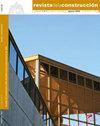带状螺旋扎带短柱轴压特性研究
IF 1.4
4区 工程技术
引用次数: 1
摘要
矩形截面的螺旋扎带作为一种新技术在施工中得到了发展,减少了钢筋生产系列中的劳动力,因为工人不必在施工现场为柱子放置扎带钢筋。本文对一种适用于约束砌体的轴压短栓柱新型栓进行了评价。本文对横截面为圆形和矩形的螺旋结与传统的闭合结进行了比较。本研究的主要目的是证明这些矩形截面螺旋拉杆可以用于约束砌体结构的拉杆柱。对21个试件进行了结构性能测试。作为结果的一部分,根据测试标准获得了试件和构件材料的最大载荷、应变、载荷-位移曲线和应力-应变关系。并对其压缩断裂能和延性指标进行了评价。结果表明,矩形截面的螺旋拉杆比传统的和圆形的螺旋拉杆具有更有效的结构响应。本文章由计算机程序翻译,如有差异,请以英文原文为准。
Axial compressive behavior of short tie-columns with strapping spiral ties
Spiral ties with rectangular cross sections have been developed as a new technology in construction, reducing the workforce in the reinforcement production series, because the worker does not have to place the tie reinforcement for the columns on the construction site. In this paper, a new type of tie was evaluated in short tie-columns subjected to axial compression to be applied in confined masonry. A comparison was made in this paper among spiral ties, with circular and rectangular cross sections, and traditional closed ties. The main aim of this research is to prove that these rectangular cross-section spiral ties can be used in tie columns for confined masonry structures. Twenty-one specimens were tested to investigate their structural behavior. As a part of the results, maximum loads, strains, load-displacement curves, and stress-strain relationships, were obtained based on testing standards, for both specimens and component materials. In addition, the fracture energy in compression and the ductility index were assessed. These results demonstrate that spiral ties with rectangular cross sections have an efficient structural response compared to traditional and circular spiral ties.
求助全文
通过发布文献求助,成功后即可免费获取论文全文。
去求助
来源期刊

Revista de la Construccion
工程技术-工程:土木
CiteScore
2.30
自引率
21.40%
发文量
0
期刊介绍:
The Journal of Construction is aimed at professionals, constructors, academics, researchers, companies, architects, engineers, and anyone who wishes to expand and update their knowledge about construction. We therefore invite all researchers, academics, and professionals to send their contributions for assessment and possible publication in this journal. The publications are free of publication charges.
OBJECTIVES
The objectives of the Journal of Construction are:
1. To disseminate new knowledge in all areas related to construction (Building, Civil Works, Materials, Business, Education, etc.).
2. To provide professionals in the area with material for discussion to refresh and update their knowledge.
3. To disseminate new applied technologies in construction nationally and internationally.
4. To provide national and foreign academics with an internationally endorsed medium in which to share their knowledge and debate the topics raised.
 求助内容:
求助内容: 应助结果提醒方式:
应助结果提醒方式:


